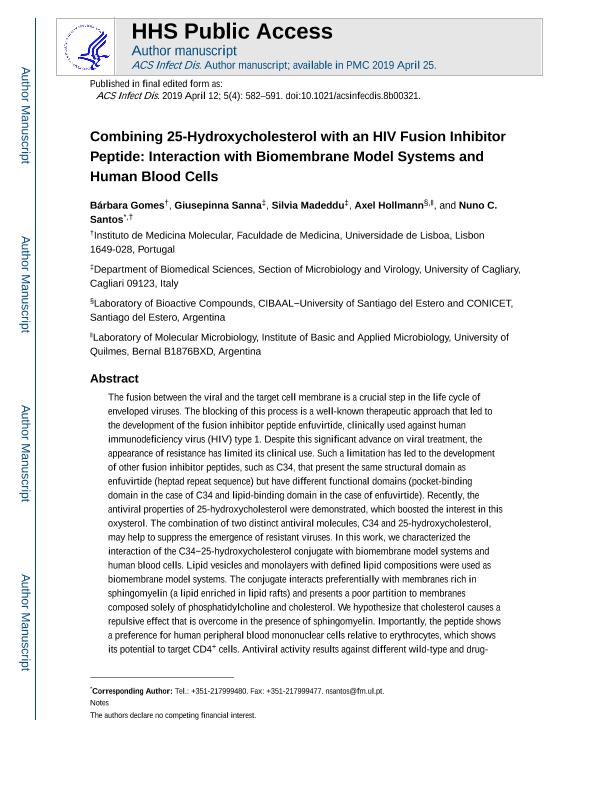Artículo
Combining 25-hydroxycholesterol with an HIV fusion inhibitor peptide: Interaction with biomembrane model systems and human blood cells
Fecha de publicación:
28/02/2019
Editorial:
American Chemical Society
Revista:
Infectious Diseases
ISSN:
2373-8227
Idioma:
Inglés
Tipo de recurso:
Artículo publicado
Clasificación temática:
Resumen
The fusion between the viral and the target cell membrane is a crucial step in the life cycle of enveloped viruses. The blocking of this process is a well-known therapeutic approach that led to the development of the fusion inhibitor peptide enfuvirtide, clinically used against human immunodeficiency virus (HIV) type 1. Despite this significant advance on viral treatment, the appearance of resistance has limited its clinical use. Such a limitation has led to the development of other fusion inhibitor peptides, such as C34, that present the same structural domain as enfuvirtide (heptad repeat sequence) but have different functional domains (pocket-binding domain in the case of C34 and lipid-binding domain in the case of enfuvirtide). Recently, the antiviral properties of 25-hydroxycholesterol were demonstrated, which boosted the interest in this oxysterol. The combination of two distinct antiviral molecules, C34 and 25-hydroxycholesterol, may help to suppress the emergence of resistant viruses. In this work, we characterized the interaction of the C34-25-hydroxycholesterol conjugate with biomembrane model systems and human blood cells. Lipid vesicles and monolayers with defined lipid compositions were used as biomembrane model systems. The conjugate interacts preferentially with membranes rich in sphingomyelin (a lipid enriched in lipid rafts) and presents a poor partition to membranes composed solely of phosphatidylcholine and cholesterol. We hypothesize that cholesterol causes a repulsive effect that is overcome in the presence of sphingomyelin. Importantly, the peptide shows a preference for human peripheral blood mononuclear cells relative to erythrocytes, which shows its potential to target CD4 + cells. Antiviral activity results against different wild-type and drug-resistant HIV strains further demonstrated the potential of C34-HC as a good candidate for future studies.
Palabras clave:
25-HYDROXYCHOLESTEROL
,
C34
,
FUSION
,
HUMAN IMMUNODEFICIENCY VIRUS
,
PEPTIDE
Archivos asociados
Licencia
Identificadores
Colecciones
Articulos (CIBAAL)
Articulos de CENTRO DE INVESTIGACION EN BIOFISICA APLICADA Y ALIMENTOS
Articulos de CENTRO DE INVESTIGACION EN BIOFISICA APLICADA Y ALIMENTOS
Citación
Gomes, Bárbara; Sanna, Giusepinna; Madeddu, Silvia; Hollmann, Axel; Santos, Nuno C.; Combining 25-hydroxycholesterol with an HIV fusion inhibitor peptide: Interaction with biomembrane model systems and human blood cells; American Chemical Society; Infectious Diseases; 5; 4; 28-2-2019; 582-591
Compartir
Altmétricas




